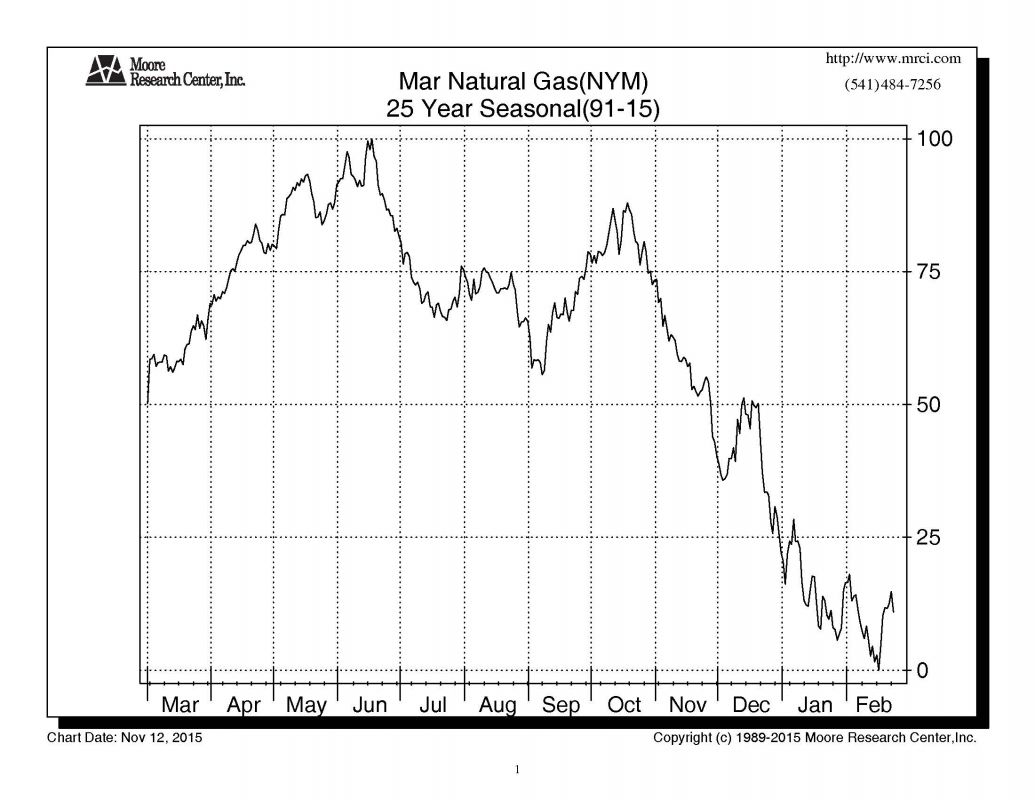If you’re looking to put some high percentage option premium in your holiday gift bag, taking the opposite tack of the public in Natural Gas could be a great bet this year.
A popular notion among the public (mostly amateur commodities traders) is that you buy natural gas ahead of winter. Gas prices, they reason, will have to rally once it gets cold out, right?
It sounds great but as with many things in investing, what sounds logical is often misleading folklore. The reality of it is this. Cold weather will indeed increase demand for natural gas. It can even have an impact on price. But both of these are at the retail level. The contract at the NYMEX is based on the wholesale value of natural gas.
The fact is, the fundamentals not only suggest that prices will not rally this year, they point to gas prices trading moderately lower by mid-winter.
The three main reasons for this are listed below.
1. The Cycle of Natural Gas Supply and Demand
Amateurs thinking they’ll “outsmart the pros” by buying gas ahead of winter are simplistically naïve. Commercial players eat, breath and sleep natural gas. Believe me, they are quite aware that it gets cold in winter.
So aware, as a matter of fact, that they begin building inventory as early as July to have enough supply on hand to meet winter demand needs. This build up to peak demand period is known as injection season (as Natural Gas distributors are buying gas at the wholesale level and injecting it into storage.)
Injection season tends to increase demand for natural gas at the wholesale level and has often been associated with firming natural gas prices.
On the flip side, at some point in autumn, adequate inventories to meet winter demand needs have often been attained. Thus, gas demand at the wholesale level begins to wane, just as it’s ramping up at the retail level. This often correlates to weakening natural gas prices into the fall and winter (see seasonal chart below.) Thus, not surprisingly, the public can often be buying natural gas just as wholesale demand begins to taper off.

Caption: Despite public perception, natural gas prices, as a whole, have historically tended to weaken into the heart of winter.
Think of it this way. You and your neighbors buy firewood for winter in the autumn. This spurs demand for firewood.. But if you buy enough for the whole winter, you won’t need any more till next year. Thus, even while you’re burning wood in your fireplace all winter long, the guy selling firewood probably isn’t going to see you or your neighbor until next year. Thus while you are actually using your wood in the winter, the firewood salesman’s demand will decline after the peak autumn “stock up” time. (For more information on seasonal tendencies and what a powerful tool they can be in commodities, read chapters 15 and 16 of The Complete Guide to Option Selling 3rd Edition)
2. Record Supplies
Although storage levels are typically high this time of year, 2015 supply has hit a new record. At 3.929 trillion cubic feet (tcf), EIA working gas in storage is not only at a record for this time of year, it’s at a historical record period. This alone should help limit “cold weather rally” attempts this winter. The chart below illustrates both the absolute current supply level and the tendency for supplies to build up until the winter heating season begins.
Natural Gas Inventories are at record highs heading into winter.
To return to the fireplace analogy, this means your woodpile out back is bigger than its ever been. Therefore, even if it’s an exceptionally cold winter, chances are you won’t need to visit your firewood guy again.
3. The Trend – Price and Economic
The trend is your friend and not just in a price chart sense. Natural gas prices have been entranced in a moderate but stubborn downtrend since seasonal highs last May. The trend towards higher gas production and an economic “risk off” trend amongst global investors are not supportive to a sudden price reversal in the immediate term.
Natural Gas Prices have been in a stubborn downtrend since May. Price strength in late summer was muted this year, possibly because outright supplies of Natural Gas are so high. Chart notes 3.40 strike price level.
Conclusion and Strategy
While the public may think that buying natural gas ahead of winter is a good ‘investment,” smart investors can take their cues from the commercial players. While sporadic “cold weather rallies” can certainly occur, overall historical trends favor lower natural gas prices into the heart of winter. Record historical supplies and a global “risk off” trend do not favor a “counter seasonal” move this year. Thus, OptionSellers.com believes the risk of a substantial move higher in Natural Gas prices this winter is minimal.
Fortunately, the public has driven up call premiums ahead of the winter months. We advise investors to seek far out of the money calls for premium sales this month and on any weather rallies in December. That’s how you sell options.
Option Sellers can consider the March 3.40 call for premiums of $500 to $600 this month. This option should not only see good time decay but is also placed above seasonal highs last May.
We’ll be working with managed client accounts this month in the timing and positioning of this trade.
If you would like to learn more about selling options in natural gas and other commodities for potentially high returns and real diversification, visit www.OptionSellers.com/Discovery to request a free investor information/discovery kit on our managed portfolios. ($1 Million recommended investment.)




